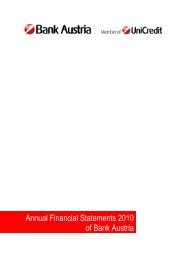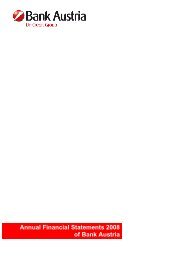Annual Financial Statements 2011 of Bank Austria
Annual Financial Statements 2011 of Bank Austria
Annual Financial Statements 2011 of Bank Austria
You also want an ePaper? Increase the reach of your titles
YUMPU automatically turns print PDFs into web optimized ePapers that Google loves.
Management Report<br />
Management Report (CONTINUED)<br />
receive assistance under multi-year IMF support programmes.<br />
The countries with the greatest resilience to external shocks are<br />
Russia and Kazakhstan.<br />
Third, the banking sector in the western European countries is<br />
under pressure (capital requirements imposed by the EBA, funding<br />
problems). This has triggered fears <strong>of</strong> a repatriation <strong>of</strong> capital<br />
from CEE, <strong>of</strong> a retrenchment <strong>of</strong> local investment or a sell-<strong>of</strong>f <strong>of</strong><br />
local assets, and <strong>of</strong> a curtailing <strong>of</strong> cross-border lending. Foreignowned<br />
regional banks account for 46% <strong>of</strong> the € 2.5 trn in total<br />
assets <strong>of</strong> the banking sector in CEE. External funding, with funds<br />
Economic growth (real GDP, % over the previous year)<br />
2009 2010 <strong>2011</strong> 2012 2013<br />
World (IMF) –0.7 +5.2 +3.8 +3.3 +3.9<br />
USA –3.5 +3.0 +1.7 +2.3 +2.5<br />
Euro area –4.2 +1.8 +1.5 +0.6 +1.6<br />
… <strong>Austria</strong> –3.8 +2.3 +3.3 +0.8 +2.0<br />
Czech Republic –4.7 +2.7 +1.7 +0.4 +2.5<br />
Slovakia –4.9 +4.2 +3.3 +2.4 +3.4<br />
Hungary –6.7 +1.2 +1.7 –0.0 +1.9<br />
Slovenia –8.0 +1.4 +0.5 –0.6 +1.1<br />
Central Europe –5.7 +2.4 +1.9 +0.5 +2.3<br />
Poland +1.6 +3.8 +4.3 +3.1 +3.5<br />
Bulgaria –5.5 +0.2 +1.6 +1.2 +1.7<br />
Romania –7.1 –1.3 +2.5 +1.4 +2.5<br />
Croatia –6.0 –1.2 +0.0 –0.5 +2.0<br />
Bosnia and Herzegovina –2.9 +0.7 +1.8 +0.5 +2.5<br />
Serbia –3.5 +1.8 +1.7 +1.0 +3.0<br />
Estonia –13.9 +3.1 +7.5 +2.6 +3.8<br />
Latvia –17.8 –0.6 +5.9 +2.9 +3.5<br />
Lithuania –14.7 +1.2 +5.2 +2.5 +2.8<br />
SEE and Baltic states –8.0 –0.2 +2.7 +1.3 +2.6<br />
Russia –7.8 +4.0 +4.3 +3.9 +4.2<br />
Turkey –4.8 +9.0 +8.5 +4.8 +4.3<br />
russia and Turkey –6.9 +5.5 +5.6 +4.2 +4.2<br />
Kazakhstan +1.2 +7.3 +7.5 +5.5 +5.8<br />
Ukraine –14.8 +4.2 +5.1 +2.0 +3.9<br />
Kazakhstan and Ukraine –8.1 +5.5 +6.1 +3.5 +4.7<br />
CEE (with Poland, GDP-weighted) –5.9 +4.3 +4.7 +3.3 +3.7<br />
CEE (without Poland, GDP-weighted) –7.0 +4.3 +4.7 +3.2 +3.8<br />
CEE (<strong>Bank</strong> <strong>Austria</strong>-weighted) *) –6.2 +3.6 +4.1 +2.4 +3.3<br />
<strong>Bank</strong> <strong>Austria</strong> market (GDP-weighted) –6.7 +4.1 +4.6 +3.0 +3.6<br />
<strong>Bank</strong> <strong>Austria</strong> market<br />
(<strong>Bank</strong> <strong>Austria</strong>-weighted) –5.5 +3.2 +3.8 +1.9 +2.9<br />
*) weighted by contribution <strong>of</strong> <strong>Bank</strong> <strong>Austria</strong>’s subsidiaries to operating income in CEE region<br />
Source: UniCredit Research. Forecasts: 7 March 2012<br />
being made available primarily by the parent company, has been<br />
practised in the banking sector in CEE on a large scale for many<br />
years. But for CEE, the short-term risk related to western European<br />
banks’ compliance with the capital requirements <strong>of</strong> the EBA is relatively<br />
low: on the one hand, a closer look reveals that capital outflows<br />
were lowest in the banking sectors where foreign banks are<br />
major players. Major banks moreover pledged themselves to a<br />
long-term commitment under the Vienna Initiative. On the other<br />
hand, the large banks announced that they would be able to meet<br />
the capital requirements by strengthening their capital base (via the<br />
market or through retention <strong>of</strong> pr<strong>of</strong>its). It has now for some time<br />
been in the interests <strong>of</strong> both sides to create a balanced business<br />
structure featuring a high proportion <strong>of</strong> funding from local sources.<br />
In the medium to long term, the CEE banking sector still has the<br />
potential to achieve growth in terms <strong>of</strong> turnover and income at a<br />
level above the EU average in view <strong>of</strong> the market penetration gap<br />
which still exists in the area <strong>of</strong> financial services. Although the<br />
amount <strong>of</strong> outstanding loans in the CEE region at the end <strong>of</strong> <strong>2011</strong><br />
totalled almost € 1.5 trn, a rise <strong>of</strong> about 9% compared with the<br />
previous year, liabilities amounted to an estimated 49% <strong>of</strong> GDP in<br />
CEE compared with 120% in the euro area. While opportunities for<br />
expanding consumer loans are limited, there is potential particularly<br />
in the area <strong>of</strong> business loans and mortgage financing. Developments<br />
among individual countries vary considerably; Russia and<br />
Turkey are likely to make the largest contribution to lending growth<br />
in the period <strong>2011</strong>–2015.<br />
Progress in overcoming<br />
the government debt crisis<br />
� The second support package for greece: On 21 February<br />
2012, representatives <strong>of</strong> the Eurogroup, the EU and the European<br />
Central <strong>Bank</strong> reached agreement with Greece on a second support<br />
package with private sector involvement (PSI). Under the agreement,<br />
the Eurogroup is prepared to provide additional funds <strong>of</strong> up<br />
to € 130 bn (by the end <strong>of</strong> 2014), with about € 90 bn being earmarked<br />
for early disbursement. The bulk <strong>of</strong> the immediate financing<br />
requirements is accounted for by a recapitalisation <strong>of</strong> the Greek<br />
banking sector (€ 50 bn) and an EFSF guarantee facility (€ 30 bn)<br />
for the remaining claims <strong>of</strong> the private sector after PSI. The PSI<br />
programme provides for write-downs <strong>of</strong> 53.5% on the nominal<br />
value <strong>of</strong> sovereign Greek debt held by private creditors, corresponding<br />
to a reduction <strong>of</strong> about € 150 bn <strong>of</strong> the total amount <strong>of</strong><br />
bonds to be redeemed by 2020. 31.5% <strong>of</strong> the restructuring<br />
amount will be exchanged (under English law) for new government<br />
bonds with maturities between 11 and 30 years. The weighted<br />
average interest rate is envisaged to be 3.65% over the 30-year<br />
<strong>Bank</strong> <strong>Austria</strong> · <strong>Annual</strong> <strong>Financial</strong> <strong>Statements</strong> <strong>2011</strong><br />
52
















